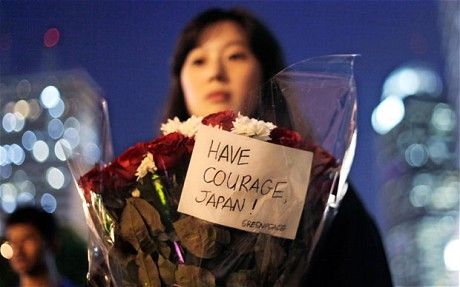
The core at reactor two of the Fukushima plant may have melted on to a concrete floor, according to experts, running the risk of radioactive gases being released into the surrounding area.
Richard Lahey, who was a head of reactor safety research at General Electric when the company installed the units at Fukushima, said the workers, who have been pumping water into the three reactors in an attempt to keep the fuel rods from melting, appeared to have "lost the race" to save the reactor.
"The indications we have ... suggest that the core has melted through the bottom of the pressure vessel in unit two, and at least some of it is down on the floor of the drywell," he told a newspaper.
"I hope I am wrong, but that is certainly what the evidence is pointing towards."
Naoto Kan, Japan's prime minister, yesterday declared a state of "maximum alert" as the country battled to overcome the combined 9.0 magnitude earthquake, tsunami and nuclear accident.
"From now on, we will continue to handle it in a state of maximum alert," he said. Mr Kan's comments came after the Tokyo Electric Power Company (Tepco), the operators of the Fukushima plant, confirmed that plutonium had been detected, for the first time, in two out of five soil samples. Tepco said the levels of plutonium were not harmful to human health, but experts said the discovery suggested the reactor's containment mechanism had been breached.
"Plutonium is a substance that's emitted when the temperature is high, and it's also heavy and so does not leak out easily," said Hidehiko Nishiyama, deputy director of Japan's Nuclear and Industrial Safety Agency.
"So if plutonium has emerged from the reactor, that tells us something about the damage to the fuel. And if it has breached the original containment system, it underlines the gravity and seriousness of this accident."
It is thought that some of the plutonium may have entered the soil from spent fuel rods at the plant or due to damage to Reactor No 3, the only one using the substance in its fuel mix.
In spite of the dangers, hundreds of staff and firefighters continued to work in shifts at the plant amid increasingly challenging conditions. According to the Mainichi newspaper, they were sleeping in a "key earthquake-proof building", the floors covered with a sheet containing lead to block out the radiation present in the building.
"The working environment is very tough," said Kazuma Yokota, head of the nuclear facility inspection office overseeing the plant.
Japan's government is facing pressure to widen the current evacuation zone, which currently extends to 12 miles. There are fears that tens of thousands of residents ordered to leave the area may never be able to return, due to the contamination. "These lands have come from their ancestors and their affection for it is enormous," said Tomo Honda, a member of Fukushima's regional assembly.
"The first step is to actually tell these refugees that they can't go back but people are not facing that reality yet."
An estimated 70,000 people have left the evacuation zone, and a further 130,000 residents living up to 19 miles away have been encouraged to leave or stay indoors. Approximately 40 residents who live with the 12-mile safety zone have refused to leave their homes.



From day one of this emergency, the Japanese officials have been understating the danger of this situation. The first reports to come out of there were simply "not even wrong"...stating that a light-water reactor COULD NOT melt down? That's exactly what is happening. When that core burns through the concrete, which it will, and hits the groundwater, Chernobyl won't have anything on this...and the Pollyanna's trying to pacify the panicked masses will probably be saying "remain calm, the contamination is not dangerous to humans" as most of the population of Japan sickens and dies, followed by the West Coast of the US, and probably much of the heartland.
The depopulationists must be having a field day, between this and the Corexit deaths in the Gulf. Their Golden Age is at hand.